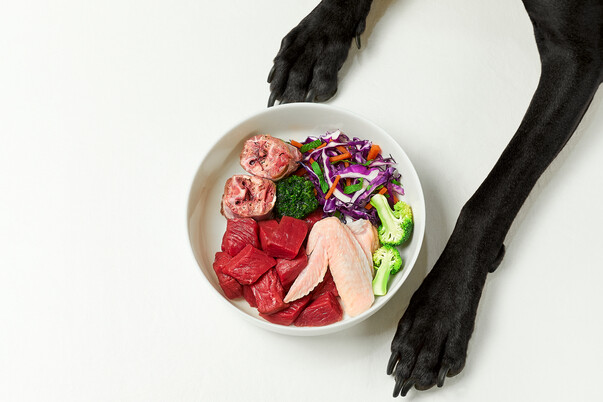What should I Include in a raw diet?
Fresh feeding guidelines – key points
Balance over time means one meal could have more bone content, another more meat or organ. The approximate ratio to aim for overall is:
• 70% Muscle Meat, Fish*, Sinew, Ligaments, Fat (10%), Skin, Fur and Feather (organic, wild, free-range if possible)
– Chicken, Turkey, Duck, Lamb, Beef, Quail, Pheasant, Pork, Rabbit, Hare, Venison, Goat, Exotic Meats
– *Oily Fish 2/3 times a week (wild caught if possible)
– Salmon, Sprats, Herring, Smelt, Mackerel, Sardines, Mussels, Oysters (unless they have a shellfish allergy)
• 10% Edible Bone
– Ribs, Wings, Necks, Wings and Carcasses (not weight bearing bones)
• 5% Liver (if you can’t source the other organs, up liver to 10%)
• 5% Other Organ Meat
– Kidney, Spleen, Brain, Testicles, Thymus, Pancreas
• 5% Veggies
-Broccoli, Cauliflower, Kale, Pumpkin, Leafy Greens, Jerusalem Artichokes, Asparagus, Butternut Squash, Mushrooms, Green beans, Red Cabbage, Parsnips, Sweet potato, Peppers, Cabbage
• 2% Fruit
– Berries; Blackberries, Raspberries, Blueberries, Red Currents, Coconut, Melon, Avocado, Pomegranate, Pears, Pineapple, Orange, Papaya
1% Seeds & Nuts (soaked, 24hours)
– Sunflower, Pumpkin, Hemp, Chia , Flax, Sesame, Almond, Walnut, Hazels, Sprouting Seeds
• 1% Herbs
– Parsley, Basil, Dandelion, Coriander, Sage, Thyme, Mint, Rosemary, Nettle
• 1% Extras
– Garlic, Ginger, Kefir, Bone Broth, Turmeric Root, Seaweed, Pink Himalayan Salt, Algaes
Things to remember
• Meats are high in phosphorus; bones are high in calcium. Ideal ratio is 1:1. That means that when you feed 10% bone, it’s usually spot on. Whole prey, whole fish, whole eggs and tripe have a balanced ratio.
• Organ meat should not exceed 10% of the diet overall and 5% of that should be liver (beef liver has the highest nutrient levels). Feed liver once a week (or several small servings per week) and try to find an organic, free-range source if possible because the liver is responsible for filtering toxins out of the body. If you can’t source the other organ meats (see above), up the liver to 10%.
• If feeding pork or fish, be certain to freeze the meat for two weeks before feeding to reduce the small risk of parasites.
• NEVER feed cooked bones of any type as when bones are cooked they become harder and are dangerous for the dog as they can splinter and pierce the stomach or intestines. Raw bones are soft enough to bend and digest easily.
• Feel free to feed ‘weird and icky things’ such as chicken feet, beef trachea, tails, lung, kidney, testicles and pizzles (penis). Beef trachea, trim and chicken and turkey feet are loaded in natural chondroitin and glucosamine which help to build healthy joints.
• We strongly recommend a nose to tail approach when fresh feeding. Each cut will provide something different. Fibre is super important which is why we’ve made sure we added fur, feathers and the veggies. Don’t skip them, they are just as important as everything else.
• Weight bearing leg and knuckle bones from large animals, such as beef, should only be fed as a play bone. Play bones can be used to make bone broth. Raw meaty bones are the sort of bones that are fully edible. They are fantastic for oral health, mental stimulation, nutrients, calcium and phosphorus, and they are rich in omega 3 fats. Other types of bones include chicken wings, rabbit quarters, turkey necks, lamb ribs and pheasant carcass. I could go on.
• If possible, try to find grass fed animals that are not given hormones or medications. Younger animals in general will have accumulated fewer toxins to pass on to your dog. Remember, it’s important to choose wisely.
• Looking after their gut health is so important. Adding fresh kefir, fermented veggies, bone broth and kimchi. Even soil! I don’t mean just digging around the garden (unless you have clean soil). I’m talking about SBO’s (Soil Based Organisms). Now there’s something for you to look up! It’s important to regularly include these into their diet.
There are many sources of information and books out there about feeding a fresh diet. Remember, what suits my pets might not suit yours. Keep a close eye on their stools. This is a great indication of what’s happening. White stools equal too much bone, dark black stools can mean too much offal, but it’s always worth checking if there’s a medical issue first. You can balance meals out by feeding a high bone meal for breakfast followed by a boneless meal for tea.

